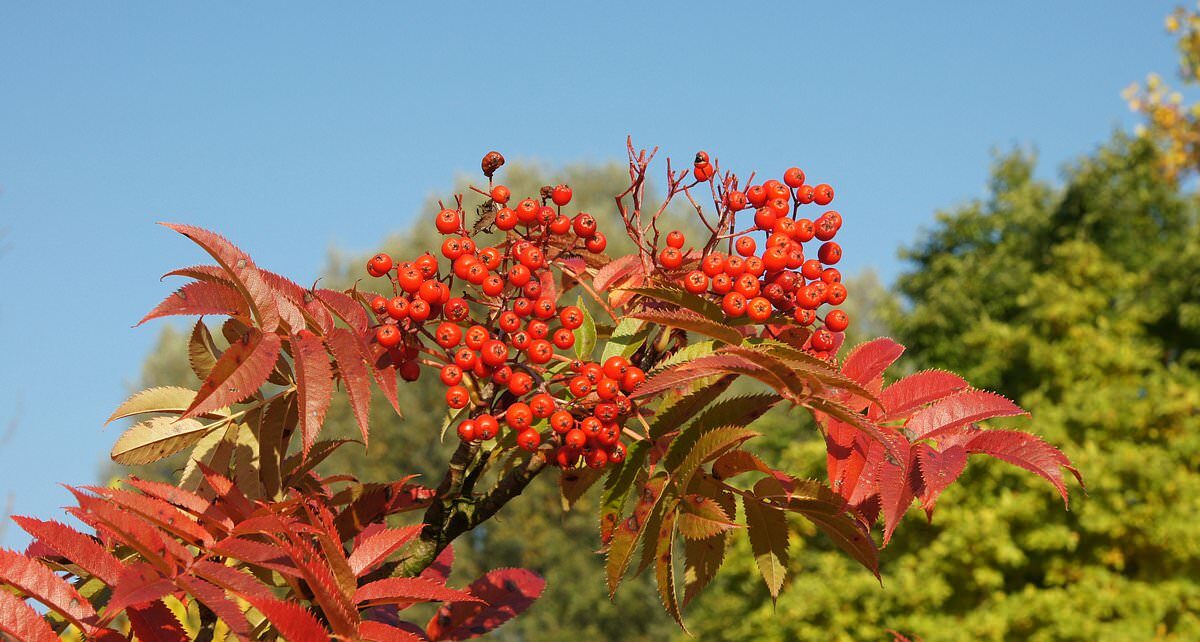All bright for Autumn: Plant ornamental trees that put on seasonal displays of striking colour
- Leaves turn orange when the green pigment breaks down as temperatures dip
- READ MORE: Action plan: CIAR BYRNE’s essential jobs for your garden this week
Pale gold, warm orange, claret red; all around us leaves on the trees are turning a spectacular range of colours.
This happens when chlorophyll, the green pigment that helps plants absorb energy from the sun, breaks down as temperatures dip, allowing other colours to come through.
Dry or sunny weather also encourages the sugar production which turns leaves red.
Late October is a magical time to admire the show deciduous trees put on before leaf fall and marks the start of tree planting season, lasting until March.
Start digging
Trees can live a long time, so you need to give them the best possible start. Prepare the ground for planting by breaking up the soil and adding organic matter if it is poor.
Dig a hole that is only as deep as the roots but two to three times as wide. It is a common misconception that trees send their roots downwards, when in fact they make a supportive base by spreading outwards. Plant your bare-root tree as soon as possible after it arrives, first giving it a good soak in a bucket of water for a few hours. Then place it in the hole, backfill with soil and firm the earth around the sapling with the sole of your boot.

For a statement tree, try Sorbus commixta (pictured) ‘Olympic Flame’, a mountain ash cultivar, with delicate leaves that turn a glowing red
One of the best trees to plant for seasonal colour is Nyssa sylvatica, or tupelo. The small slow-growing tree comes from North America and thrives in swamps. It is also happy in welldrained acid to neutral soil. It has an upright habit and oval green leaves which turn bright red and yellow in autumn.
Sweet gum (Liquidambar styraciflua) is another mediumsized North American tree with glossy maple -like leaves, growing deep red in autumn. Persian ironwood (Parrotia persica) is admired for its seasonal amber to ruby display. Its bark peels away to reveal the younger bark beneath, and in late winter it bears unusual red flowers with no petals, instead producing stamens from a bud resembling pomegranate seeds. It prefers well-drained soil and sun or partial shade.
The maidenhair tree, Ginkgo biloba, is part of a species dating Fiery red: Japanese rowan (Sorbus commixta) makes a bold statement back 170 million years. It has been widely cultivated throughout human history and its fanshaped leaves are used in Chinese medicine. The leaves turn bright gold at this time of year.
Make a splash
For a statement tree, try Sorbus commixta ‘Olympic Flame’, a mountain ash cultivar, with delicate leaves that turn a glowing red. This rowan was selected from seed by a Swedish botanist in 1976 and is now a garden favourite.
It likes free draining soil and grows up to 6m high. For smaller gardens, Japanese maples (Acer palmatum) are compact and slow growing with a graceful shape and leaves which turn rich butter yellow or auburn.
They are perfect for a large container if you have only a tiny outside space or balcony. Preferring light shade, they don’t need too much pruning or training. Acers do well in most soils, but if you grow one in a container combine a peat-free ericaceous compost with sharp sand for better drainage.
With Halloween and Bonfire Night here soon, this is the best time of year to enjoy the toffee apple tree, Cercidiphyllum japonicum, an attractive small tree with heart-shaped leaves that turn pale gold and pink.
Another ornamental Japanese tree with fine foliage is Prunus sargentii or Sargent’s Cherry. It sports pink blossom in spring and bronze leaves in autumn.
Source: Read Full Article


